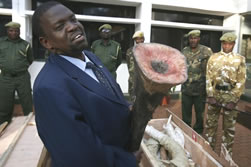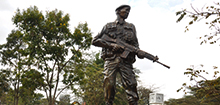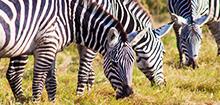
Date Published: 27 Jul, 2009
Approximately 280kg of raw elephant ivory and two 18kg rhino horns totaling 1million USD was impounded at the Jomo Kenyatta International Airport on Tuesday 14, 2009 by Kenya Wildlife Service law enforcement officers in liaison with Customs officers.
The trophies suspected to be from a Southern African elephant country were illegally destined to Laos, Asia from Mozambique via Nairobi. The captured trophies were registered in the name of Xaysavang Trading Export Import Company Limited and destined to Paxsan District-Bolikhamxay Vientiane-Laos.
“Since Mozambique has no rhinos and elephants we suspect the trophies were illegally poached from neighboring countries and transported to Maputo by road” said KWS Director Julius Kipng’etich.
“We will be doing a DNA to determine where the elephants were illegally poached from but it is highly possible it was in Tanzania, Namibia, Zimbabwe or South Africa” continued Mr. Kipngetich.
The trophies will remain in Kenyan custody and a property of the Kenyan government until the matter is legally adjourned. Kenya, Laos People’s Democratic Republic and Mozambique are signatories to CITES and are expected to enforce the provisions which provides for seizure of illegally traded listed CITES wildlife and its products.
There has been an upsurge of illegal elephant poaching in countries with poor wildlife law enforcement since the 2007 CITES (Convention on International Trade in Endangered Species of Wild Fauna and Flora) decision to lift the 9year ban on international trade in ivory. The decision allowed for a one-off sale to China and Japan by four South African countries; Botswana, Namibia, South Africa and Zimbabwe.
Kenyan wildlife management pales in comparison with their Southern African counterparts. At least 100 rhinos have so far been illegally killed this year in the Southern Africa wildlife ecosystem, this triggered by the CITES decision.
“KWS has intensified its law enforcement to protect the country’s rhinos and elephants” said the KWS Director, “It is a sad day for us all, the rhinos and elephants are a wildlife heritage that belongs to all of us”
Background on KWS and CITES
The country’s elephant’s population was 170,000 at independence in 1969 but had reduced to a mere 16,000 in 1989. In May 1989 Kenya along with many other nations proposed the listing of the African elephant on Appendix 1 of the CITES (Convention on International Trade in Endangered Species of Wild Fauna and Flora).
In October of the same year the Parties to the CITES voted to list the African elephant to Appendix 1, thus banned the international trade in ivory and other elephant product. With these changes the other condition for Kenya’s elephant improved dramatically with the population rising to some 26,000 elephant by 1996.
However the June 1997 decrease by COP 10 to CITES down listing the elephant to Appendix 2 in some Southern Africa country’s to allow limited trade in ivory have stimulated ivory poaching in Kenya’s elephant range.
Kenya’s outcry is to totally stop the bloody elephant trade to help this charismatic species.





